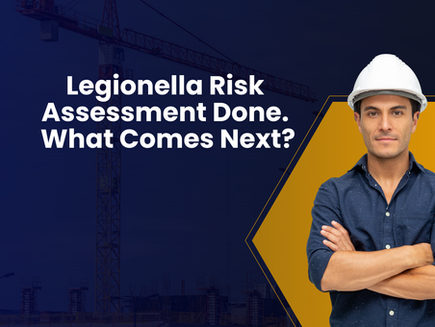top of page

School's Out!
Welcome To Our Learning Centre
Everything you need to know about water hygiene and
legionella control, all in one place


Choosing the Right Ball Valve for Your Cold Water Tank: A Comprehensive Guide
As a facilities manager, ensuring the efficient operation of your building's water systems is paramount. Selecting the appropriate ball valve for your cold water storage tanks is crucial for maintaining optimal performance and compliance with water regulations. This guide explores various types of ball valves, including equilibrium straight arm, equilibrium drop arm, and several models from Keraflo's Aylesbury range, to help you make informed decisions tailored to your facil
Apr 45 min read


How to Install an Unvented Water Heater
Ensuring reliable hot water for your building isn’t just a convenience—it’s essential for safety, hygiene and operational continuity. That’s why more facilities managers are choosing unvented water heaters for their buildings. These systems deliver hot water at mains pressure, without the need for a bulky cold water storage tank , offering improved performance and cleaner installs. In this guide, we’ll walk you through what you need to know to plan, install, and maintain an
Apr 43 min read


Difference Between TMV2 and TMV3
As a facilities manager, you're responsible for ensuring that every system in your building runs safely and efficiently - and that includes your hot water systems. One of the most critical components in managing water temperature safely is the thermostatic mixing valve (TMV). But when it comes to TMV2 vs TMV3 , what’s the real difference — and which one should you be using? Let’s break it down clearly so you can make the right call for your site. What Are Thermostatic Mixing
Mar 313 min read


Legionella Risk Assessment Completed – Here’s What Facilities Managers Must Do Next
So, you’ve had your Legionella risk assessment completed. Great start - that puts you ahead of many. However, the most important part now is taking action . The evaluation itself won’t protect your building, users, or your compliance status. It’s what you do next that matters. In this guide, we’ll walk you through the key steps to take after an assessment, outline your legal obligations, and show you how to put a watertight Water Safety Plan in place - all with a practical,
Mar 313 min read


My Water Tank Is Leaking - What Should I Do?
Discovering a leak in your facility's water tank can be both daunting and disruptive, potentially leading to significant property damage and operational downtime. But if you discover a leak in your water tank , don’t panic. Often, leaking water tanks can be repaired, so there’s no reason to assume the problem is going to cost the earth to resolve. As a facilities manager, understanding the causes, immediate actions, and long-term solutions is crucial to maintaining the integ
Mar 312 min read


How Often Should Legionella Risk Assessments Be Carried Out?
As a facilities manager , ensuring the safety of your building’s water systems is a critical responsibility. One of the biggest risks? Legionella bacteria , which thrive in water systems and can cause Legionnaires’ disease - a potentially fatal form of pneumonia. To stay compliant and protect building occupants, you need to conduct regular Legionella risk assessments . But how often should these be carried out? This guide breaks down best practices, legal requirements , an
Mar 243 min read


The Difference Between Potable and Non-Potable Water
As a facilities manager , ensuring your building’s water systems are safe, efficient, and compliant is a top priority. But one fundamental distinction is often overlooked: the difference between potable and non-potable water . Understanding this difference is crucial for health, compliance, and cost-efficiency . In this guide, we’ll break down what each type means, where they should be used, and how to manage them safely in your facility. What is the Difference Between Pota
Mar 243 min read


3 Tips For Choosing a Legionella Remedial Work Specialist
Ensuring the safety and compliance of your facility's water systems is paramount, especially when it comes to mitigating the risks associated with Legionella bacteria . Choosing the right Legionella remedial specialist is a critical decision that impacts both the health of building occupants and adherence to legal obligations. Here's a comprehensive guide to assist you in making an informed choice. Understanding Legionella and Its Risks What is Legionella? Legionella is
Mar 143 min read


Legionnaires Disease: What Facilities Managers Need to Know
Legionnaires' disease is a serious, potentially fatal form of pneumonia caused by Legionella bacteria , commonly found in man-made water systems. As a facilities manager, understanding the risks, legal requirements, and best practices for controlling Legionella is crucial to ensuring compliance and maintaining a safe environment. What is Legionnaires' Disease? Symptoms and Risks Legionnaires' disease develops after inhaling aerosolised water droplets contaminated with Legio
Mar 142 min read


Why Are Legionella Remedial Works So Important?
Legionella bacteria pose significant health risks in water systems, potentially leading to serious illnesses like Legionnaires' disease . As a facilities manager, ensuring your building’s water systems are safe and compliant is crucial. The Importance of Legionella Remedial Works Health Risks and Compliance Legionnaires' disease is a severe, sometimes fatal, form of pneumonia caused by inhaling water droplets contaminated with Legionella bacteria. The Health and Safety Execu
Mar 72 min read
bottom of page






